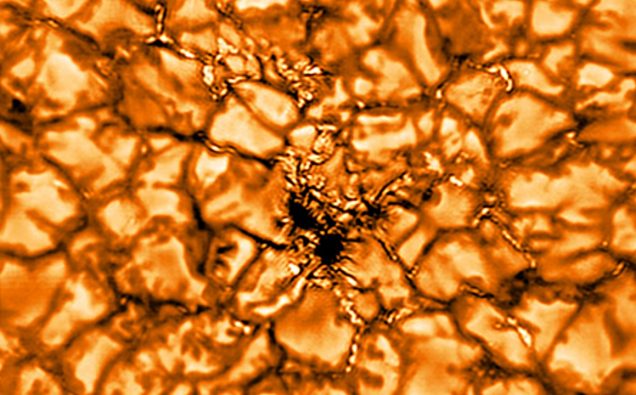
Europe’s largest solar telescope GREGOR reveals intricate structures of solar magnetic fields in very high resolution. The image was taken at the wavelength of 516 nm. Credit: KIS
If you look at the featured picture without reading the headline what would be your first impression? Molten gold, an intricate design, or an enchanting gold ornament?
But none of these.
It is the surface of the sun. The image shows some awe-inspiring and scary exploding fires surging upwards.
A series of images captured by GREGOR, the largest solar telescope in Europe provide a rare higher resolution sight of what might be going on the star of our system.
GREGOR is operated by a German consortium and located on Teide Observatory, Spain. The laboratory has obtained unprecedented images of the fine-structure of the Sun.
The images come after a major redesign of GREGOR’s optics that was carried out by a team of scientists and engineers from the Leibniz Institute for Solar Physics (KIS), the Institute said.

A sunspot observed in high resolution by the GREGOR telescope at the wavelength 430 nm. (Click to play)
The sun can be observed at a higher resolution than before from Europe.
Earlier this year NASA also released some unbelievable images of the sun’s surface.
The sun has so much importance to our living on the planet Earth.
According to the researchers studying the magnetism on the sun, can lead to an understanding of the magnetism’s influence on Earth and minimize the damage of satellites and technological infrastructure.
“The GREGOR telescope allows scientists to resolve details as small as 50 km on the Sun, which is a tiny fraction of the solar diameter of 1.4 million km. This is as if one saw a needle on a soccer field perfectly sharp from a distance of one kilometer.”
“This was a very exciting, but also extremely challenging project. In only one year we completely redesigned the optics, mechanics, and electronics to achieve the best possible image quality,” said Dr. Lucia Kleint, who led the project and the German solar telescopes on Tenerife.
The images have been the result of a major technical breakthrough achieved by the project team in March this year, during the lockdown, when they were stranded at the observatory and set up the optical laboratory from the ground up.
But at that time snowstorms prevented solar observations, the Institute said.
When Spain reopened in July, the team immediately flew back and obtained the highest resolution images of the Sun ever taken by a European telescope.

A sunspot observed in high resolution by the GREGOR telescope at the wavelength 430 nm. Credit: KIS
Prof. Dr. Svetlana Berdyugina, professor at the Albert-Ludwig University of Freiburg and Director of the Leibniz Institute for Solar Physics (KIS), is very happy about the outstanding results:
“The project was rather risky because such telescope upgrades usually take years, but the great teamwork and meticulous planning have led to this success. Now we have a powerful instrument to solve puzzles on the Sun.” The new optics of the telescope will allow scientists to study magnetic fields, convection, turbulence, solar eruptions, and sunspots in great detail.
The KIS said the first light images obtained in July 2020 reveal astonishing details of sunspot evolution and intricate structures in the solar plasma.
Telescope optics are very complex systems of mirrors, lenses, glass cubes, filters, and further optical elements. If only one element is not perfect, for example, due to fabrication issues, the performance of the whole system suffers, according to the Institute.
The GREGOR team found several of those issues and calculated optics models to solve them. For example, astigmatism is one of such optical problems, which affects 30-60% people’s vision, but also complex telescopes. At GREGOR this was corrected by replacing two elements with so-called off-axis parabolic mirrors, which had to be polished to 6 nm precision, about 1/10000 of the diameter of a hair. Combined with several further enhancements the redesign led to the sharp vision of the telescope, the KIS explained.











